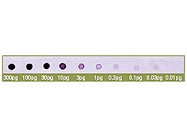
The Biotin DecaLabel™ DNA Labeling Kit manufactured by Fermentas is a good alternative to radiolabeling for DNA in a variety of hybridization procedures. It is inherently safer than radiolabeling since it eliminates the reliance on radioactive chemicals. Anyone who works with radioactive compounds will know of the inconvenience and health hazards that surround them even in the relative safety of a controlled lab environment.
I do not use this kit extensively but found it to be appealing when I was searching for alternatives to radiolabeling a DNA probe that I wanted to use for Southern blotting. Southern’s are gradually fading away as the method of choice for detection of DNA fragments in an era when robust and relatively easy PCR reactions can provide the same answers. However, sometimes Southern blotting can provide insight into biological backgrounds that is more difficult to obtain by newer and more sophisticated technologies. In my case, I wanted to confirm the uniqueness of two transgenic lines that were expected to be independent transformants. They were wielding the same phenotype but suspected errors in original labeling led us to believe the two lines could very well have been one and the same. In order to differentiate these we decided to do a Southern blot and probe a region of DNA that was conserved in the inserted gene. Our restriction profile on the Southern would be able to tell the lines apart.
The Biotin DecaLabel™ DNA Labeling Kit was used at this stage to label a 240 bp fragment of DNA that was conserved between both of the antisense constructs. The method works by incorporating nucleotides bound to biotin onto the synthesized probe. Biotin-11-dUTP is provided in the kit along with 1 mM of all the NTP’s. Random decamer primers are also provided which enable complimentary strand synthesis. Biotin labeled DNA can then be detected using a biotin-streptavidin detection system. Biotin can be detected at low amounts and this sensitivity enables testing small quantities of DNA. Theoretically, a few nanograms of DNA should be able to give a detectable biotin signal.
The method itself is easy. Anywhere between a 100 ng – 1 ug of DNA template are used in 10 ul volumes as the starting material. I would recommend higher amounts if using biotin labeling for Southern blots. For other applications, such as dot/slot, Northern blots, colony screening or in situ hybridization, the quantities of DNA needed may vary. This 10 ul sample of DNA is mixed in with water and the decanucleotide containing reaction buffer and then boiled to denature the DNA. The biotin labeling mix is then added and the sample is incubated at 37°C overnight. Longer incubation results in higher quantities of labeled DNA probe, which is then ready to use for hybridization applications.
Research Associate
Dept of Biological Sciences
Royal Holloway University of London